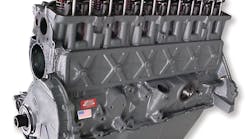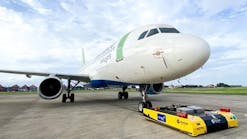By Scott Strong
The 4.2L Ford fuel-injected gasoline engine has done a lot to make GSE easier to start and more reliable. They start just like the vehicles our ramp workers drive every day – no pumping the pedal to set the choke or take the choke off. All of this is now done electronically.
Emergency cut-off features that can be programmed into the unit’s computer also help maintain the equipment. When the engine hits 220 degrees, for example, the computer can limit the amount of throttle the operator can use in an attempt to keep the unit from overheating. If the engine still overheats or the oil pressure drops, the engine shuts off to protect itself. This keeps us from having to rely on the operator to look at and understand the gauges on the dash.
That’s all good news. The not-so-good news is that for those of us who have spent a long time working on carbureted Ford 300s, these new fuel systems can be a real puzzle. I cannot tell you how many phone calls I have with GSE techs around the country that start with “Well, the code was for “X” so I replaced the fuel pump, the fuel filter, the throttle position sensor, the oxygen sensor … .”
I can only imagine how many parts were replaced that never needed to be replaced. We really have to take a look at how we are diagnosing these systems and stop guessing. The old Snap-on Tools diagnostic sales pitch really needs to be our motto when it comes to repairing drivability problems on 4.2L systems: “Test … Don’t Guess!”
A NEW SERIES
This is the first in a series of “Maintenance Matters” columns that will delve into how this fuel delivery system works and provide some tips for diagnosing the problems associated with some common drivability issues.
As we all know, information is the key to being able to diagnose problems with this system. There is no substitute for the proper description and operation articles, wiring diagrams and trouble code charts.
Most manufacturers include a subsection on the 4.2L and related diagnostics information in their equipment manuals. The good news is that this system is almost universal no matter the manufacturer. Although power supply wiring may differ, for the most part, the codes, operation and engine wiring harnesses are all the same. If you have the diagnostic information in a manual from one GSE manufacturer, it will certainly help to figure out the issues on a piece of equipment made by another.
Remember, the trouble codes and internal Engine Control Module programming all come from Ford. The equipment manufacturer is able to customize features, such as max engine RPM, governed vehicle speed and whether the engine will be protected from low oil or overheating.
Other than these differences, the system works the same in all types of GSE. Once you learn how to work on a Tug 660 beltloader, you will be able to apply this knowledge directly to a Harlan cargo tractor.
The only real additional information that you need is to determine where the code switch is located. Here’s a tip: Check the operation of the code switch. Because of where these switches are located and the weather that they are often exposed to, it’s common to find these toggle switches not working electrically anymore. This results in an erroneous “no code” situation.
Remember, if the engine light is not doing what you think it should, remove the switch from the circuit and perform a resistance check on it. If the switch has gone bad, simply jumping the two wires together will put the ECM into diagnostic mode and allow you to use the engine light to determine what if any trouble codes are stored.
Next issue we will talk about the theory behind how these systems work and what the sensors’ jobs are. After that we will delve into how to pull codes and diagnose problems. Throughout this series I will also try to include some quick common failure repairs you can mentally file away just in case they come in handy when working on one of these units.
ABOUT THE AUTHOR: Scott Strong is the national manager, Global Aviation Services LLC, a GSE and facilities maintenance service provider with 15 locations through the country.



